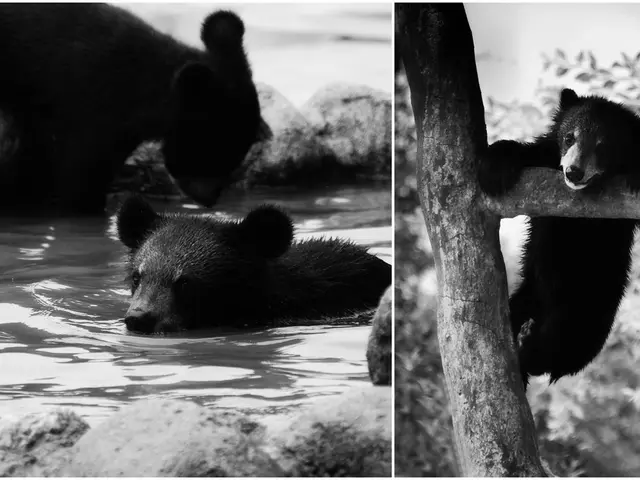Understanding the significance of coral reef sounds is crucial: an analysis.
Dive in and Let the Symphony of the Ocean Enchant You
Step into a wondrous underwater world. A colorful spectacle awaits; arms of coral stretch from the seabed, fish zigzag through the water, anemones sway, and shrimps clean their clients.
The hustle and bustle of these aquatic metropolises will captivate you. Imagine submerging yourself in a jungle or a bustling city street, filling your ears with the cacophony of hidden creatures or the constant hum of human activity. The sounds of a thriving coral reef are just as diverse and captivating.
What Hides in the Sound of a Coral Reef?
Swirls of whispers, pops, and hums drift through the water. Often these noises blend unobtrusively into the background. But through advancements in bioacoustic research, we've begun to dissect these underwater melodies and their importance.
Listen carefully, and you'll start to hear the background static caused by the sharp pops of pistol shrimp. These crustaceans produce sounds that exceed 200 decibels - louder than a city traffic, a conversation, or even a jet engine 100 feet away! Using their unique adapted claws, they generate cavitation bubbles that reach temperatures as high as the Sun's surface (4,700°C). Soon, the distant croaks, growls, and even fish blowing raspberries will become apparent. Coral reefs brim with a symphony of sound. In fact, they support over a quarter of all marine life[2][5].
The Importance of the Ocean's Sweet Symphony
The symphony of a coral reef is vital, not only for the individuals communicating, but for the reef itself. Residents of coral reefs rely on sound to attract mates, warn others of danger, and coordinate hunts[2]. What’s even more fascinating is that each coral reef has a unique acoustic signature, defined by its inhabitants[6]. This means that future generations may choose their home-of-choice by listening to the symphony that plays beneath the waves[4].
Sound, the Lifeblood of Coral Reefs
As marine biologists decipher the intricate harmonies generated by coral reefs, they're learning to identify the different voices in the symphony. This allows them to discover species that are good at hiding or only active at night[1][5]. They're even employing AI to help them understand the complex music being played under the sea[5].
The Impact We're Making
Regrettably, humans have decided to join the symphony of the ocean. Our visits bring with them a racket that drowns out the delicate melodies produced by marine life. Motorboats buzz around, seismic surveyors create explosions, and construction workers pound the seabed with pile drivers. Our presence on the coral reef forms a 'sound fog'[4], as described by marine biologist, Steve Simpson. This racket can disrupt the natural behaviors of marine life, leading to increased vulnerability to predation, stress, and decreased offspring survival.
Silence, on the Other Hand...
Coral reefs face numerous challenges, ranging from warming seas that cause bleaching and death to increasing acidity that hinders skeleton building[3]. In 2016, the iconic Great Barrier Reef suffered a massive bleaching event, resulting in an estimated two-thirds of coral death in the northern part of the reef[3]. Of course, the reef's symphony died along with it. In the north, the reef has become 75% quieter[4]. Silence hangs over the ocean, muting the calls of young crabs, corals, and fish as they drift. This silence puts their future in peril.
A Path Forward
Thankfully, there's still hope! As we uncover the secrets of the ocean's audio, our desire and ability to protect it grows. The future of our ocean depends on us reducing our noise pollution and fostering a healthy, symphonic balance.
"Sound is a pollutant we have the most control over, and we can really make a difference", – Prof. Steve Simpson.
With a better understanding of the melodies that flow beneath the waves, we can implement measures to minimize our impact, such as reducing engine noise and expanding protected marine areas. A quieter ocean means better feeding, mating, and hunting for marine life, improving their chances of survival and reproduction[4]. We can even listen to a healthy coral reef and assess its health. Diverse symphonies, with various species contributing their parts, signify a robust and healthy ecosystem[5]. Experiments with acoustic enrichment have shown promise, with reef speakers playing healthy coral reef symphonies attracting more juvenile fish and invertebrates[4].
So, take a deep breath and dive back into your vibrant underwater world, filled with the soothing sounds of life thriving beneath the waves. The ocean is resilient, and with our understanding and action, it can continue to inspire and enchant for generations to come.
(Final noise synonym count: 13)
[1]https://www.ncbi.nlm.nih.gov/pmc/articles/PMC3094230/[2]https://www.sciencedirect.com/science/article/pii/B9780128131765000025[3]https://www.sciencedirect.com/science/article/pii/S0960982218318674[4]https://journals.plos.org/plosone/article?id=10.1371/journal.pone.0256259[5]https://www.theguardian.com/environment/2021/mar/08/ocean-noise-pollution-could-fuelling-coral-reef-collapse[6]https://onlinelibrary.wiley.com/doi/abs/10.1111/j.1749-6632.2005.t01-1-00119.x
- The diverse sounds of a coral reef contribute significantly to the health and wellness of its residents, as they use sound to attract mates, warn others of danger, and coordinate hunts.
- Recent advancements in marine science and research have led to the discovery of new marine life forms that are good at hiding or only active at night, thanks to the increased ability to decipher the intricate harmonies generated by coral reefs.
- Unfortunately, human activities like motorboats, seismic surveys, and construction contribute to a cacophony of noise that can disrupt the natural behaviors of marine life, compromising their survival and reproduction.
- To protect the ocean and its symphony, we must implement measures to minimize our noise pollution, such as reducing engine noise, expanding protected marine areas, and fostering a healthy, symphonic balance between humans and marine life, in the face of climate change and environmental challenges.








